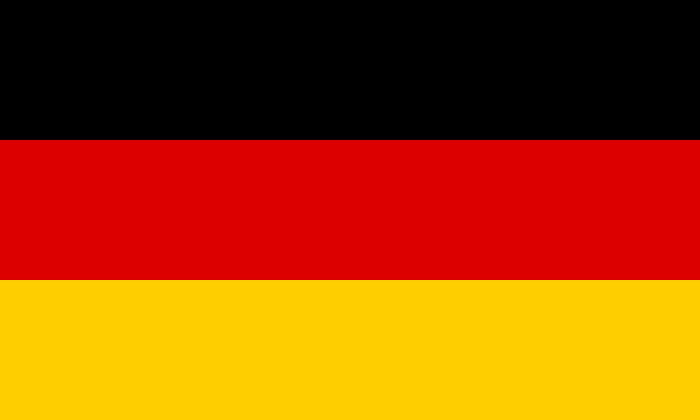
German~American Day
06 October 2021

The American Community Survey, compiled between 2008 and 2012 and being the most recent analysis, identified 34% of the total population of Bedford County as descending from German ancestors, making them the largest population in the county.
On 6 October 1683 Germantown, Pennsylvania was founded and that date has been celebrated every year since 1883 when the first German Day was celebrated. One hundred years later, in 1983, President Ronald Reagan proclaimed the day as German~American Day. The celebration of German~American Day in the U.S. coincides with celebrations of Oktoberfest in Germany and often includes similar festivities.
The influx of German (and Swiss) immigrants in the years 1682 and 1683 into the colony of Pennsylvania was the direct result of a promotional scheme by the colony's proprietor, William Penn Jr. The colony had been granted to Penn, but he was tasked with obtaining enough families to settle in it to justify its existence. His solution was to publish a brochure advertising the colony's selling points ~ its broad expanses of arable land and the promise of religious freedom ~ and then to distribute them in Germany. Large numbers of Swiss and German families who were fleeing from their homes because of persecution for their religious beliefs were tempted to make the trip across the Atlantic Ocean. Settling initially in the eastern counties of Pennsylvania where they landed, many of the immigrant families eventually made their way to the frontier of Bedford County.
The first petition to abolish African~American slavery in the Colonies was submitted to the English Parliament by German Quakers on behalf of the residents of Germantown in 1688.
The American Revolutionary War, and the curtailment of travel from Europe to North America, led to a drop off of German immigration into Pennsylvania. By 1820 immigration once more began to rise and for a century nearly seven million Germans emigrated from their homeland to find new lives in the United States. Then, in the 1930s with the persecution of many Germans as Adolf Hitler's Nazi party took over Germany, the number of German immigrants once more rose in North America. Despite their effort to escape from the Nazi takeover of their country, Germans who now embraced America as their homeland found that they were being persecuted by non-Germans. They persevered, though, and thrived.
Not only did the German immigrants survive and thrive in their new homeland on the North American continent, they made many contributions to the betterment of that new homeland. Some of the most prominent contributions came in the form of rich holiday traditions and scientific knowledge. Christmas, as celebrated today in the United States, has especially been influenced by German traditions. The Christmas tree and singing of Christmas Carols come from our German ancestors. German immigrants, themselves, became a valuable contribution. German scientists who had fled the stifling Nazi takeover were often leaders in their fields, but now contributing to U.S. rather than German interests. Scientists such as Albert Einstein and Wernher von Braun helped to advance U.S. interests in the fields of theoretical physics and aerospace research. Von Braun's innovations in the field of rocket technology contributed to the U.S. being able to compete with the U.S.S.R. in the space race.
Along with parades, German~American Day is commonly celebrated with parties entertained by 'oopah bands' playing traditional polkas. Men dress in lederhosen and women dress in dirndl. Lederhosen is short or knee-length leather breeches made from tanned deer hides. They usually have attached suspenders of the same material and are worn with either a plain white or checkered shirt. Over-the-calf stockings complete the outfit. The dirndl for women consists of a high-waisted skirt and a close-fitted bodice with low neckline worn over a blouse. The outfit was completed with an apron over the skirt.
German~Americans celebrate by feasting on what is perhaps the most popular 'German' food: Sausages (known as Wurst in Germany) and Kielbasa. Sausage is any type of meat that is ground up, sometimes mixed with breadcrumbs or other grains as fillers and then flavored with herbs. Kielbasa is specifically sausage produced in Poland, but German~Americans often use the names interchangeably. Types of sausages produced and enjoyed by Germans include Bratwurst (primarily comprised of pork), Bockwurst (primarily comprised of veal), Knackwurst (primarily comprised of veal and pork and flavored with garlic), Currywurst (primarily comprised of pork and flavored with curry) and Liverwurst (comprised primarily of pig or calf liver) along with the standard Frankfurter or Weiner. Those are just the most popular types. There are nearly fifty types of sausage available. In almost all cases, sausage is fried. It can, though, be heated by boiling it in water. There are also types of sausage, such as liverwurst or Gelbwurst (pork or veal mixed with ginger and nutmeg) which are sliced and eaten cold in sandwiches.
Despite its popularity, sausage is not the only type of meat enjoyed by German~Americans. Hendl is the German name for broiler chicken. Hendl is prepared on a rotisserie that keeps the whole chicken turning on a spit. It is often marinated in lemon, garlic and spices. Sauerbraten and Kippered or Pickled Fish are quite popular in German cuisine. Sauerbraten is beef that is marinated in vinegar and spices. The word 'kippered' means 'smoked' and kippered fish are small fish (primarily herring), which have been pickled first and then cold-smoked in smouldering wood chips. In pickling, the herring is cured in salt, then the salt is removed and the herring is marinated in vinegar and spices. Jagerschnitzel is pork that is coated with eggs and bread crumbs and then fried in oil until browned. A mixture of onions, mushrooms, beef bouillon, cornstarch and sour cream is cooked on low heat until it thickens. Then it is poured over the fried pork. Roasted pork knuckle, or Schweinshaxe, is the ham hock, or lower part of the pig's leg above the ankle, which has been marinated for a couple days (to soften the tendons) and then roasted. Hasenpfeffer is rabbit braised in a gravy composed of red wine, shallots, bacon and currant jelly. Veal was noted above as being the main ingredient of a type of sausage, bockwurst. Veal, minced finely, is also a main ingredient (along with ground sirloin and pork) in a meatball, commonly known as 'German Meatballs.' The three meats are mixed together with eggs, bread crumbs and milk and formed into balls which are simmered in a broth of white wine, stock and cider vinegar. The meatballs are then covered with a sauce made from sour cream and lemon juice mixed with a variety of flavorings including capers, anchovies and pepper.
Sausages and other meat dishes are often paired with Sauerkraut. Sauerkraut is finely grated cabbage that is fermented by lactic acid bacteria. Sauerkraut originated in China in the 7th and 6th Centuries BC and was introduced into Europe by the Tartars under Ghengis Khan. In order to produce sauerkraut, raw cabbage is shredded and placed in a large container. Canning or pickling salt is added to the cabbage and it is left to sit while the salt causes the liquid in the cabbage to seep out. The process will take only a short time, perhaps as few as ten minutes. The cabbage is then squeezed to force more of its liquid out. Kneading and squeezing the cabbage helps to mix the salt completely among the cabbage. The cabbage mash is then transferred to a fermenting crock or jar and tamped down tight. The cabbage mash should be covered by at least two inches of the liquid that has been squeezed out. If there is not enough liquid, additional 'brine' can be made by boiling four and one-half teaspoons of canning salt to one quart of water until the salt is completely dissolved. The cabbage mash is then weighted down and left to ferment for three to four weeks at 70 to 75 degree temperature. During the fermentation process, bubbles will rise to the top and form a foam on the surface. That foam, or scum, is skimmed off and when the bubbling stops, the fermentation is finished. Sauerkraut is traditionally cooked with some sort of meat to add flavor to it. German~Americans tend to use pork loin with the sauerkraut and pork cooked for three to four hours or until the meat pulls apart easily. Some people add sausage to the sauerkraut instead of pork. Sausage can be added in the form of links or removed from its casing and crumbled up and mixed in. And it should also be mentioned that some people add brown sugar to the sauerkraut or even tomato ketchup.
Stews and soups are made from a wide variety of vegetables, such as carrots, turnips and cabbage. Eintopf is considered a traditional stew throughout many regions of German and among German~Americans. The thing about Eintopf is that there is no single recipe for it. It basically consists of any number of different vegetables cooked in a stew with some type of meat. It would correlate to the way that basic 'vegetable soup' is created in the United States.
Aside from sauerkraut, cabbage forms the basis of quite a number of traditional German dishes. Savoy Cabbage and Turnips consists of the savoy type of cabbage boiled with turnips and carrots. Unlike green cabbage, which is the most common type of cabbage, savoy cabbage does not disintegrate when cooked. That characteristic makes savoy cabbage fine to use for Borscht. Wrapped around a mixture of loose sausage and rice, cabbage forms the 'blanket' for the popular dish known in Pennsylvania Dutch regions as Pigs in a Blanket. The wrapped 'pigs' are then topped with stewed tomatoes and baked. In Germany they are called Kohlroulade, not to be mistaken for Rouladen which is thin slices of beef wrapped around a mixture of bacon, pickles, onion and mustard. Rouladen is then basted with red wine and roasted. Paired with noodles, shredded cabbage forms a common German side dish: Haluski.
Bratkartoffeln is a dish whose main ingredient is the potato. The dish is commonly known to German~Americans simply as 'German Fries.' Potatoes are sliced thin and then fried along with bacon and onions in vegetable oil or butter. German Fries are seldom served as the main course; instead it is a favorite side dish served with sausage or ham. Kartoffelsalat, known more commonly as 'Potato Salad' is another dish that is very popular among German~Americans. Potatoes and eggs are boiled and then diced up and mixed with diced onions and celery. To the entire mix is then added mayonnaise or sour cream. The dish can be served warm, but most often is served cold.
Knodel is a side dish that is better known to German~Americans as 'dumplings.' The German word, Knodel is pronounced similarly as 'noodle' and refers to something that is kneaded. Knodel consists of dough balls made from flour or bread, which can be stuffed with some sort of meat, but most often is not. Dumplings made from bread are called Semmelknodel and are made by mixing dried bread, milk and egg yolks. They are usually added to chicken dishes along with gravy or noodles. A type of dumpling, Maultaschen is similar to ravioli or pierogi. Small pockets of pasta dough are filled with diced beef mixed with spinach, onions and bread crumbs and then boiled. Tradition states that the dish was invented by the Cistercian monks of Maulbronn in the Seventeenth Century. Since any type of meat was forbidden during Lent, the monks came up with the idea of filling pasta dough pockets with the forbidden meat. They assumed that by 'hiding' the meat in the dough, God would not see that they were eating it. While speaking of noodles, a type of noodle eaten with dumplings is Spatzle. It refers to an egg noodle, a type of pasta made with eggs, flour, salt and water.
One German dish to be noted is not really a 'dish' at all, but a feast. Spanferkel is the German name for 'pig roast'. This uniquely German event consists of roasting an entire small 'suckling' pig in an oven or on a grill. The meat throughout a roasted suckling pig is tender while the skin will become crisp and can be used to make pork rinds. As the Spanferkel is being roasted, it will be cooking in its own juices. But it can also be basted for additional flavor. A common basting is made by mixing apple juice with apple cider vinegar and vegetable oil. The pig roast can also be basted with beer.
Many ethnic groups enjoy some form of pizza and the Germans are no different. Their version is called Flammkuchen. It consists of flatbread dough on which a layer of heavy cream and sour cream is topped by diced bacon and thinly sliced onions. In the absence of any type of tomato sauce, the 'pizza' resembles what we find in the United States called 'white' pizza.
German~American cuisine is not complete without including Brezels or as German~Americans know them: Pretzels. The twisted and baked pieces of dough originated in the Germanic city-states as early as the 600s. They are most often believed to have been invented by monks as a way to keep bread dough from molding. The actually date and reason for their creation is not known, but they are known to have come from a very ancient time.
The most beloved German dessert is perhaps Apple Strudel. Strudel is a type a pastry originating in Austria. It is traditionally made of dough kneaded very vigorously and rolled out very thin. It has been said that you should be able to read a newspaper through it if it is thin enough. Some sort of fruit filling (most often, apple) is spooned onto it, then the dough is wrapped around the filling and it is baked. The resulting pastry is flaky and delicate ~ seeming to melt in your mouth. Kasekuchen is another favored German desert. The name translates as 'cheesecake.' German cheesecake is lighter than cheesecake often found in the Unites States. Instead of cream cheese, the German version uses 'quark,' made by warming soured milk to produce something between yogurt and cottage cheese. Egg foam is folded into the quark to make the fluffy filling. It is flavored with lemon and vanilla. The filling is poured into a flour and egg yolk crust in the traditional German recipe. German~Americans tend to pour the filling into a crust made of crushed graham crackers.
In regard to the drinks that are traditionally German, none are more evocative of German heritage than Beer. The proliferation of micro-breweries throughout the United States in the recent decades have fueled the celebration of German~American Day along with the coincident Oktoberfest festivities. Besides beer, Sekt, a sparkling wine similar to champagne, is very popular. Many people might never have heard about Sekt, but they will no doubt have heard the names by which Sekt has been marketed, including Pinot Noir, Pinot Blanc, Pinot Gris and Riesling. Coming in a close third is Schnaps, a fruit liqueur with Peppermint Schnaps being the most popular. Fruit punches have always been popular among German~Americans. In Germany a punch is known as Bowle and consists of fruit juices mixed with Sekt in which actual pieces of fruit are floated. A non-alcoholic version is Kinderbowle suitable for children.
Additional Information Might Be Added Here. Please Check Back.
Click on this logo to return to the Calendar page.

